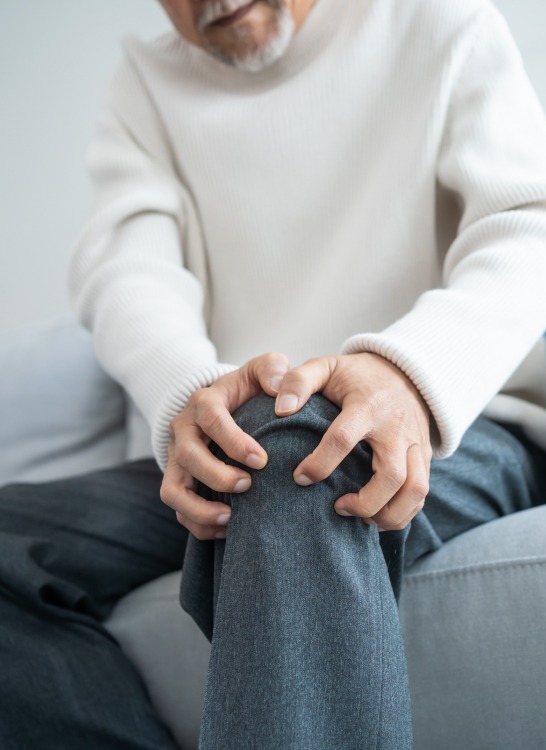Osteoarthritis

Osteoarthritis is the most common age-related form of arthritis, often called “wear-and-tear arthritis.” It occurs when the protective cartilage that cushions the ends of bones wears down over time, affecting joints like the knees, hips, spine, and hands.
Common Signs & Symptoms
- Joint pain and stiffness, especially after rest or inactivity
- Swelling and tenderness in the affected joint
- Cracking or popping sounds when the joint moves
- Reduced flexibility and limited range of motion
- Joint deformity in advanced stages
- Muscle weakness around the joint due to disuse
Chakrasiddh Therapy Benefits for Osteoarthritis
Chakrasiddh approaches osteoarthritis holistically, targeting pain, inflammation, and joint function through traditional therapies.
Key Benefits of Siddha Therapy:
- Thokkanam (medicated strokes/massage) improves circulation, reduces stiffness, and promotes joint mobility
- Varmam therapy activates energy points to relieve pain and restore function
- External applications of oils, and hot-water fomentation reduce swelling and joint discomfort
- Dietary modifications help detoxify the body, improve bone health, and manage chronic inflammation
- Yoga and gentle exercises customized for OA help maintain flexibility and strengthen surrounding muscles
- Various Yoga assana aids in reducing stress, improving sleep, and enhancing overall well-being
At Chakrasiddh, many osteoarthritis patients report less pain, improved joint movement, and a better quality of life—without the side effects of conventional painkillers or steroids.
Why Is Osteoarthritis Called a “Degenerative Disease”?
Osteoarthritis is often referred to as a degenerative or progressive joint disease because it worsens slowly over time. Unlike autoimmune arthritis (such as rheumatoid arthritis), osteoarthritis is not driven by the immune system but by mechanical stress, age-related changes, and lifestyle factors. Key contributors include:
- Repeated stress on joints from physical labor or sports
- Natural aging and cartilage thinning
- Obesity adding pressure to weight-bearing joints
- Previous joint injuries or surgeries
- Genetic predisposition
This gradual degeneration is why early Osteoarthritis treatment is essential to preserve mobility and prevent disability.
How Does Osteoarthritis Impact Daily Life?
Osteoarthritis isn’t just about joint pain—it affects independence and quality of life. Patients often struggle with:
- Difficulty standing up from a chair or climbing stairs
- Trouble walking long distances due to knee or hip pain
- Reduced grip strength affecting simple tasks like opening jars
- Sleep disturbances due to nighttime pain
- Emotional challenges such as frustration, anxiety, or depression
At Chakrasiddh, our holistic Osteoarthritis treatment doesn’t only reduce pain but also restores function and emotional well-being, empowering patients to regain confidence in daily living.
Can Lifestyle Changes Slow Osteoarthritis Progression?
Yes. While osteoarthritis cannot always be reversed, lifestyle modifications can significantly slow its progression and relieve symptoms:
- Weight management – Reduces pressure on joints, especially knees and hips.
- Balanced diet – Foods rich in calcium, vitamin D, and anti-inflammatory nutrients support joint health.
- Regular movement – Gentle exercises and yoga keep joints mobile and muscles strong.
- Avoiding overuse – Adjusting posture, work setup, and activity levels prevents excess strain.
- Stress reduction – Practices like meditation and breathing exercises improve pain tolerance and mental resilience.
Siddha therapies at Chakrasiddh complement these strategies, offering natural pain relief and long-term support.
Frequently Asked Questions
Can osteoarthritis be cured?
No, osteoarthritis cannot be cured—current medical understanding confirms that cartilage damage cannot be reversed. However, symptom management and functional improvement are very possible. Treatments such as pain medications, physical therapy, bracing, and lifestyle changes can significantly ease discomfort and preserve joint mobility over time. At Chakrasiddh, our Siddha-based approach incorporates therapies like Thokkanam, Varmam activation, joint fomentation, dietary detox, and targeted yoga offers effective, medication-free relief that supports long-term joint health and reduces dependency on painkillers.
When does osteoarthritis occur?
Osteoarthritis is typically age-related, emerging most frequently in adults over 50, sometimes even earlier due to joint injuries, structural irregularities, or genetic vulnerability. The wear-and-tear process gradually thins cartilage and stresses nearby tissues, leading to stiffness, pain, and reduced mobility. Understanding this progression helps guide both conventional management and holistic care strategies like those at Chakrasiddh, which focus on prevention and early intervention.
Are osteoarthritis and osteoporosis the same?
No, they are different conditions. Osteoarthritis is a joint condition involving cartilage degeneration, while osteoporosis is a systemic bone condition characterized by low bone density and increased fracture risk. Osteoarthritis often causes pain and joint dysfunction, whereas osteoporosis typically remains symptomless until a fracture occurs. Because both conditions can coexist, especially in older adults, maintaining joint and bone health through therapy, nutrition, and lifestyle—like our Siddha methods—offers comprehensive support.
What is the best remedy for osteoarthritis?
The most effective approach to easing osteoarthritis combines multiple strategies:
- Conventional treatments: Pain relievers, physical therapy, joint support devices, heat/cold therapy.
- Lifestyle interventions: Exercise, weight management, and balanced nutrition significantly reduce symptoms.
- Emerging therapies: Techniques like gene therapy hold future promise, although not yet mainstream.
- Siddha-based care at Chakrasiddh: Therapies such as Thokkanam massage, Varmam energy activation, warm-oil applications, and detoxifying diets work together to reduce pain, restore mobility, and support bodily balance—often with lasting benefits and zero side-effects.
